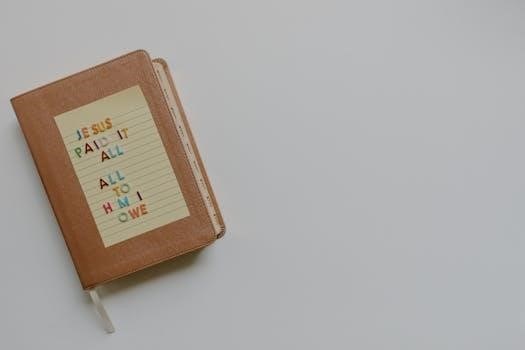Soundarya Lahari⁚ Overview
The Soundarya Lahari, attributed to Adi Shankara, is a revered text comprising 100 Sanskrit verses. It is divided into two parts, praising Goddess Parvati’s beauty, with tantric elements included. This work is considered a significant devotional text.
The Soundarya Lahari, meaning “waves of beauty,” is a collection of 100 Sanskrit verses that form a powerful hymn dedicated to the goddess Parvati. Attributed to the sage Adi Shankara, this sacred text is not just a devotional poem but also a tantric manual. It beautifully describes the divine beauty of the goddess while also including instructions on rituals, mantras, and yantras associated with her worship. The text is divided into two sections, Ananda Lahari and Soundarya Lahari, each exploring different aspects of the divine feminine.

Authorship and Origin
The authorship of Soundarya Lahari is traditionally attributed to Adi Shankara. The text’s origin is linked to a mythical etching of Ananda Lahari on Mount Meru by Lord Ganesha.
Attribution to Adi Shankara
The Soundarya Lahari is widely believed to be composed by the revered Hindu philosopher and theologian, Adi Shankaracharya. This attribution is based on traditional accounts and the text’s philosophical depth which aligns with his teachings. Adi Shankara’s authorship enhances the text’s spiritual significance, making it a crucial work in the Advaita Vedanta tradition. His profound understanding of the divine feminine is reflected throughout the verses, further solidifying his association with this sacred text.
The Mythical Ananda Lahari Etching
A captivating myth surrounds the Ananda Lahari, the first part of Soundarya Lahari. It is believed that Lord Ganesha himself etched these sacred verses onto Mount Meru. This divine origin elevates the text’s importance, suggesting its profound spiritual power and celestial authority. This story underscores the text’s significance within tantric traditions, portraying it as not merely a human creation but a divine revelation. The tale adds a layer of mystical reverence.

Content and Structure
The Soundarya Lahari consists of two parts⁚ Ananda Lahari and Soundarya Lahari. It praises Goddess Parvati, incorporating tantric elements like rituals, mantras, and yantras within its verses.
Two Parts⁚ Ananda and Soundarya Lahari
The Soundarya Lahari is traditionally divided into two distinct sections. The initial section, known as Ananda Lahari, comprises the first 41 stanzas and is often translated as “waves of happiness.” The subsequent section, known as Soundarya Lahari, encompasses the remaining verses and is translated as “waves of beauty.” This division highlights both the joyful and aesthetically beautiful aspects of the divine feminine form, as expressed in the text. The text is considered a significant work in tantric literature.
Praise of Goddess Parvati
The core of the Soundarya Lahari is the profound praise of Goddess Parvati, the divine feminine. The verses describe her beauty, grace, and power in intricate detail, going beyond mere physical attributes to capture her spiritual essence. The text uses poetic language to explore both her manifest and unmanifest aspects. It’s a hymn to the divine mother, celebrating her as the source of creation and the embodiment of cosmic energy, central to the Shakta tradition.
Tantric Elements⁚ Rituals, Mantras, Yantras
The Soundarya Lahari incorporates significant tantric elements, detailing specific rituals, mantras, and yantras associated with Goddess Parvati. Each verse can be linked to a particular yantra, used for meditation and worship. These elements are not merely symbolic; they are meant to be tools for spiritual practice. The text also describes the use of mantras for invoking the Goddess’s power and achieving specific spiritual goals, making it a practical tantric guide.
Availability and Formats
The Soundarya Lahari is widely accessible in PDF versions online. It is also available in various languages, including English, Hindi, and Telugu, catering to diverse audiences and readers.
PDF Versions and Digital Access
Numerous digital versions of the Soundarya Lahari are available online, often in PDF format, allowing for easy access and download. These digital versions cater to a wide audience, enabling individuals to study and appreciate this sacred text from various devices. Some platforms offer scanned copies, and it’s notable that some digital versions may have missing pages, highlighting the need for more complete and accurate digital resources. Many resources are available for free, but it is advisable to check the source’s credibility.
Different Language Editions (English, Hindi, Telugu etc)
The Soundarya Lahari is available in various languages, catering to a diverse readership. Translations and transliterations exist in English, Hindi, Telugu, and other Indian languages. These editions aim to make the text accessible to individuals who are not fluent in Sanskrit. The availability of these translations allows for a broader understanding and appreciation of the text’s poetic and spiritual content. These editions are available in both print and digital formats, further broadening their reach, and increasing their availability to spiritual seekers.

Key Aspects and Interpretations
The Soundarya Lahari focuses on the beauty of the divine feminine, with detailed commentaries and translations aiding understanding. Interpretations often highlight the text’s tantric and devotional aspects.
Focus on Beauty and Divine Feminine
The Soundarya Lahari, meaning “waves of beauty,” centers its verses on the exquisite form and divine attributes of Goddess Parvati. It elevates the feminine divine, exploring her physical beauty as a manifestation of cosmic energy. The verses paint vivid pictures, using rich poetic language to convey the goddess’s allure and power. This focus emphasizes the importance of the divine feminine in spiritual realization, blending aesthetics with devotion;
Detailed Commentaries and Translations
The Soundarya Lahari has been the subject of numerous commentaries, aiding in its understanding and interpretation. These detailed analyses often provide insights into the tantric elements, mantras, and yantras included within the verses. Translations into various languages, including English, Hindi, and Telugu, make the text accessible to a broader audience. Some commentaries offer transliterations alongside original Sanskrit verses, enriching the study of this profound work. These resources are valuable for both scholars and devotees alike.
Gita Press and Related Publications
Gita Press publishes Shankaracharya’s works, potentially including Soundarya Lahari. Their publications are available in various languages. These texts are often found in bookstores or online platforms, offering spiritual resources.
Gita Press Shankaracharya Books
Gita Press, a well-known publisher of Hindu religious texts, offers a range of books attributed to Shankaracharya. These publications often include his commentaries and works on Advaita Vedanta philosophy. It is plausible that a version of Soundarya Lahari could be among their catalog. The availability of these books provides access to authentic spiritual literature, making them valuable for scholars and devotees alike. The focus is on preserving traditional knowledge through these carefully printed editions.
Availability of Gita Press Versions
Gita Press publications, including possible editions of the Soundarya Lahari, can often be found through their official website and various online retailers. These versions might be available in different languages, such as Hindi, and possibly English. The books are generally accessible in both printed formats and sometimes as digital resources. Their presence on online platforms facilitates easier access for a broader audience seeking spiritual and philosophical texts, making them widely available for purchase and study.

Related Works and Interpretations
Musical adaptations, such as ‘Flood of Beauty’, exist alongside texts like the Devi Gita. These works offer diverse interpretations of the Soundarya Lahari and its underlying themes.
Musical Adaptations like ‘Flood of Beauty’
The Soundarya Lahari’s profound verses have inspired various artistic interpretations, notably including musical adaptations. One prominent example is ‘Flood of Beauty,’ an orchestral work by John Tavener, which sets all 100 verses of the text to music. Such adaptations aim to convey the emotional and spiritual essence of the original Sanskrit verses through musical forms, allowing a broader audience to engage with the text’s beauty and depth. These musical renditions often complement the devotional and contemplative aspects of the Soundarya Lahari.
Devi Gita and other connected texts
The Soundarya Lahari is often studied alongside other related texts that delve into similar themes of divine feminine power and devotion. The Devi Gita, for instance, is another significant scripture that explores the nature and importance of the goddess. These texts, including works translated by figures like Anton Zovolokin, provide a broader context for understanding the philosophical and spiritual concepts presented in the Soundarya Lahari. Exploring these interconnected works enriches the reader’s comprehension of the broader Shakti tradition and its rich literary heritage, often focusing on similar devotional and philosophical paths.
Specific Issues and Inquiries
Some scanned PDF versions of the Soundarya Lahari are reported to have missing pages. Users seek restored access to these incomplete books, hoping publishers can address the issue.
Missing Pages in Scanned PDFs
A recurring issue reported by readers is the presence of missing pages within scanned PDF versions of the Soundarya Lahari. Specifically, page 85 and the corresponding page 45 in the book have been noted as absent in some digital copies. This incompleteness disrupts the reading experience, as the text is not fully accessible. Such instances highlight the need for complete and accurate digital versions of important religious texts like this one. This problem affects the study of the text.
Seeking Restored Access to Books
There is a general call from the community to restore access to various books, including the Soundarya Lahari. This involves contacting publishers and platforms to make these works more readily available. The importance of preserving and sharing these texts digitally is being stressed. The need for complete and accurate versions is especially emphasized for spiritual texts. It is a priority that the publishers address the challenge of access to older publications and ensure readers can access these works.
Additional Resources
Online bookstores and platforms offer various editions of the Soundarya Lahari. Audio and narration versions are also available for those seeking alternative ways to engage with the text.
Online Bookstores and Platforms
Numerous online platforms and bookstores provide access to the Soundarya Lahari in various formats, including digital versions and printed editions. These platforms often feature different language versions, such as English, Hindi, and Telugu, catering to a diverse readership. Websites like Amazon and Flipkart, along with specialized spiritual book stores, offer these texts, making it convenient to explore the profound teachings and verses of the Soundarya Lahari. Some platforms may also offer free PDF downloads, while others provide scanned versions.
Audio and Narration Versions
Audio versions of the Soundarya Lahari are available, providing an alternative way to engage with the text. These narrations often include the original Sanskrit verses along with translations and explanations, enhancing understanding and accessibility. Platforms like YouTube host narrated renditions, allowing listeners to experience the devotional and poetic aspects of the text. Such audio formats cater to those who prefer listening over reading, making it easier to absorb the teachings.



































